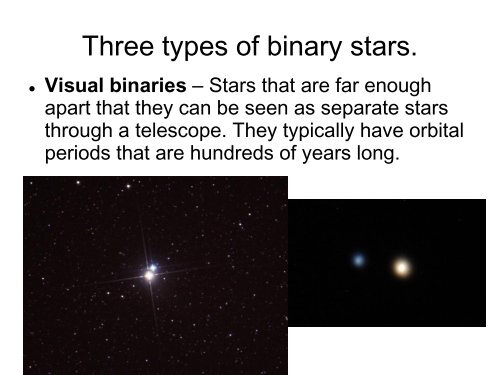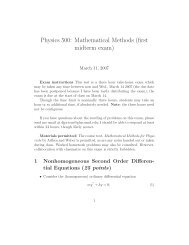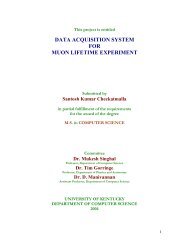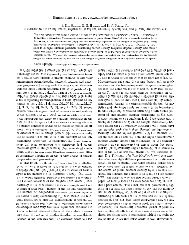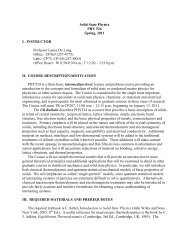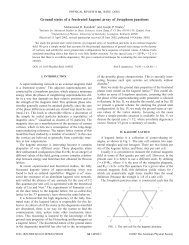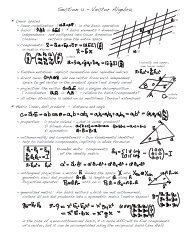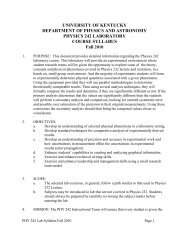Three types of binary stars.
Three types of binary stars.
Three types of binary stars.
Create successful ePaper yourself
Turn your PDF publications into a flip-book with our unique Google optimized e-Paper software.
<strong>Three</strong> <strong>types</strong> <strong>of</strong> <strong>binary</strong> <strong>stars</strong>.<br />
• Visual binaries – Stars that are far enough<br />
apart that they can be seen as separate <strong>stars</strong><br />
through a telescope. They typically have orbital<br />
periods that are hundreds <strong>of</strong> years long.
Stars orbit a common center <strong>of</strong> mass. More<br />
massive star has smaller orbit.
• Spectroscopic Binaries – Much shorter orbital<br />
periods because <strong>stars</strong> are so close to each<br />
other that they aren’t separable. But the<br />
spectral lines show that there are two <strong>stars</strong>.
A Dilemma<br />
• Spectroscopic binaries <strong>of</strong>ten show double the<br />
absorption lines <strong>of</strong> a regular spectrum. But the<br />
wavelength at which a line forms does not<br />
depend on the type <strong>of</strong> star. It is set by the<br />
element that is giving <strong>of</strong>f the light. Why don’t<br />
the two absorption lines fall right on top <strong>of</strong> each<br />
other?
A Dilemma<br />
• Spectroscopic binaries <strong>of</strong>ten show double the<br />
absorption lines <strong>of</strong> a regular spectrum. But the<br />
wavelength at which a line forms does not<br />
depend on the type <strong>of</strong> star. It is set by the<br />
element that is giving <strong>of</strong>f the light. Why don’t<br />
the two absorption lines fall right on top <strong>of</strong> each<br />
other?<br />
• The reason is the Doppler Shift.
The Doppler shift is a wave phenomenon<br />
• When an object emits a wave, the wave moves<br />
out in all directions with its center at the source.<br />
• This is true <strong>of</strong> water waves, sound waves, and<br />
light waves.
What if the source is moving?<br />
• If a source <strong>of</strong> the wave is moving, then as the<br />
source emits the wave, the center is<br />
continuously moving.
Here is a real picture <strong>of</strong> Doppler shift
When a star is moving toward or away from<br />
us Doppler shift is blue-ward (toward) or redward<br />
(away) <strong>of</strong> what it would be if the star<br />
was not moving.
We can see this as a shift in the absorption or emission<br />
lines in a spectrum. The wavelength that absorption<br />
occurs at depends only on the type <strong>of</strong> atom. But the shift<br />
depends on the motion
• Using the Doppler shift <strong>of</strong> light from a star we<br />
can not only tell if the star is coming toward us<br />
or going away from us, but we can also<br />
measure the speed at which it is moving toward<br />
or away.
How is the velocity related to the<br />
amount <strong>of</strong> Doppler shift?<br />
1. The faster the object is<br />
moving toward or away from<br />
us the bigger the shift should<br />
be.<br />
2. The faster the object moves<br />
toward or away from us the<br />
smaller the shift will be.<br />
3. If an object is moving rapidly<br />
towards us we get a large<br />
speed, but if it is moving<br />
rapidly away we get a small<br />
speed.
Relation <strong>of</strong> velocity to Doppler shift<br />
• The bigger the shift the fast the velocity<br />
because the center <strong>of</strong> the wave is moving<br />
rapidly causing greater compression or<br />
expansion.<br />
• v/c = Δλ/λ o<br />
• where v is the velocity, c is the speed <strong>of</strong> light,<br />
λ o is the rest wavelength and Δλ is the doppler<br />
shift. Δλ = (λ observed – λ o )
What about <strong>stars</strong> orbiting each<br />
other?<br />
• The result is two absorption lines that have slightly<br />
different wavelengths from what they have in the lab.
Binary star simulator<br />
• http://astro.ph.unimelb.edu.au/s<strong>of</strong>tware/<strong>binary</strong>/<strong>binary</strong>.htm
What will happen if I put the two <strong>stars</strong> closer<br />
together?<br />
1. They will speed up<br />
2. They will slow down<br />
3. They will remain at<br />
the same speed
What did we find out?<br />
• When the <strong>stars</strong> are farther apart (a is increased)<br />
they move more slowly in their orbit.
How can we find the orbital period for<br />
spectroscopic binaries?<br />
1. Watch the <strong>stars</strong> orbit each<br />
other and see how long it<br />
takes<br />
2. Watch for the absorption<br />
lines to return to their original<br />
wavelength<br />
3. Measure the masses and<br />
compute the period
What did we find out?<br />
• When the <strong>stars</strong> are farther apart (a is increased)<br />
they move more slowly in their orbit.<br />
• Measuring the time it takes for the spectral lines<br />
to return to their starting wavelength gives us<br />
the orbital period
What will happen I make Star #1 mass three<br />
times Star #2 mass?<br />
1. Star #2 will have a<br />
bigger orbit than Star #1<br />
2. Star #2 will a smaller<br />
orbit than Star #1<br />
3. The orbits will not<br />
change
What did we find out?<br />
• When the <strong>stars</strong> are farther apart (a is increased) they<br />
move more slowly in their orbit.<br />
• Measuring the time it takes for the spectral lines to<br />
return to their starting wavelength gives us the orbital<br />
period<br />
• When the mass <strong>of</strong> one star is increased the other star<br />
orbits at a greater distance.
If Star #2 is orbiting 3 times faster than Star #1,<br />
what does that tell you about their masses?<br />
1. M 1 = 3M 2<br />
2. M 1 = M 2 /3<br />
3. M 1 = M 2
What did we find out?<br />
• When the <strong>stars</strong> are farther apart (a is increased) they<br />
move more slowly in their orbit.<br />
• Measuring the time it takes for the spectral lines to<br />
return to their starting wavelength gives us the orbital<br />
period<br />
• When the mass <strong>of</strong> one star is increased the other star<br />
orbits at a greater distance.<br />
• If M 1 = 3M 2 then star #2 will orbit 3 times faster than<br />
star #1
Let’s look at Kepler’s Law<br />
• (M 1 + M 2 )P 2 = (4π 2 /G)a 3<br />
• So we have the relative masses<br />
• We have the period.<br />
• We just need a 3 .<br />
• But v orbital = 2πa/P or a = v orbital *P/2π<br />
• So how do we find v orbital ?
How can we get the orbital velocity <strong>of</strong> the <strong>stars</strong>?<br />
1. Measure the Doppler shift for<br />
any spectroscopic <strong>binary</strong> pair<br />
2. Use the peak radial velocity<br />
from the velocity plot to get<br />
the orbital velocity.<br />
3. Find binaries which are<br />
eclipsing, because we are<br />
then in the orbital plane and<br />
can determine v orbital
Eclipsing Binaries
• If the <strong>binary</strong> <strong>stars</strong> are eclipsing, then it is<br />
guaranteed that we are in the orbital plane.<br />
• This means that the maximum radial velocity on<br />
the velocity plot gives us the orbital velocity.<br />
• Now we have “a” and we have “P”. We can get<br />
rid <strong>of</strong> one <strong>of</strong> the “M”s because we know how<br />
they are related.
Example<br />
• (M 1 + M 2 )P 2 = (4π 2 /G)a 3<br />
• If M 1 = 3M 2 then we can write:<br />
• (3M 2 + M 2 )P 2 = (4π 2 /G)a 3<br />
• (4M 2 ) = (4π 2 /G)(a 3 /P 2 )<br />
• Once we find M 2 we know that M 1 is three times<br />
the mass
Masses <strong>of</strong> Stars<br />
• Many such measurements show us that mass<br />
increases on the Main Sequence as the temperature<br />
and luminosity increase. As theory predicts.<br />
• Furthermore, Mass does not correlate with luminosity<br />
for giant, evolved <strong>stars</strong>. Giants might have a large<br />
mass, or they might have a small mass, but still they<br />
are very luminous.<br />
• Also the mass <strong>of</strong> a white dwarf is not correlated to its<br />
luminosity.<br />
• Something different is happening for these guys.


